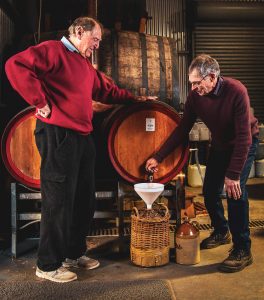
FAQ’s Home Barrel Seasoning, Blending & Ageing
What is Tawny style Port wine?
Tawny style wine actually starts out like a Ruby or unwooded fortified, but then spends an extended period in oak barrels to soften and round out its character. As wooden staves allow oxygen to enter, this allows some of the wine to evaporate which concentrates flavours in the remaining wine. The slight gap of air at the top of the barrel increases the surface area exposed so the wine is basically slowly oxidising inside the barrel. The wine deepens in colour changing slowly from red-purple eventually to a dark amber or reddish-brown. The longer time in wood, the more complex the wine flavour profile and the smoother the wine becomes.
What do I fill a new barrel with?
Firstly, you need to know if the new keg is made from older red wine barrels or old fortified wood. Both keg types need initial warm to hot water treatment to lessen wood tannin impact on the new wine. The red wine oak barrel should have younger wine such as Ruby Grenache or Ron’s Blend to start with to help soak up the greater wood tannins, known as ‘seasoning’. An oak barrel previously used for fortified wine is best started with Ron’s Blend,as the barrel usually retains some wood tannins which will complement the fruit-foward wine.If wine remains a little woody, keep topping up with youthful Tawny, until the wine seems balanced with fruit and wood characters.
How often should I top up my barrel?
Top barrel according to usage; for infrequent use, it’s best to top with younger wine and if wine is poured frequently, a more mature Tawny such as Keg Blend is recommended. The barrel should not be emptied below 1/3 total volume. ?Note that a new barrel will absorb quite a bit of wine in the beginning.
How often should I taste my barrel wine?
Taste often, especially when using a new barrel as oak flavour can build up quickly in a wine. This will of course vary according to barrel size and cellar conditions (temperature and humidity) and whether the barrel wood was used for red wine or fortified wine. A smaller barrel will need more frequent tasting than a large barrel.
What is the typical lifespan of a barrel?
Well it depends on the purpose of the barrel. If you are looking to impart both flavours from the wood and structure in the form of tannins, a new oak barrel will continue to enhance wine for 4-5 years. After this the barrel becomes neutral and its main purpose becomes a storage vessel. The wine quality can still develop and improve as flavours will concentrate due to evaporation of some water content of the wine and also through exposure to oxygen. Generally, any barrel can last a lifetime and even generations if it never runs dry of good quality wine and is kept away from extreme heat, high humidity and sunlight.
How do I restore an old barrel?
A barrel that has been dry for some time and is loose is best taken to a Cooper to “knock up”, otherwise a handy person can use a hammer and blunt metal object to tighten the rings Then do a water treatment. A?second hand barrel with unknown history, it is wise to empty the barrel and start over again. Rinse out the barrel with hot water (1/10 volume of the barrel) at least twice so the top and bottom interior surfaces are covered and soaked for at least 30 minutes. Then fill with cold water and allow swelling for up to 3 days to check for any slow leaks. If barrel still leaks after 3 days then drain and refill. If any off-odours are present (e.g. vinegar, medicinal) the barrel can be rejuvenated by fermenting sugar and water in it, followed by a hot water rinse before filling with fortified wine. Check with a cooper or keg supplier if in doubt.
I’m moving house. How do I transport my barrel?
A barrel that will be empty for more than a few days needs some preparation to be stored correctly. Empty the wine into well-sealed containers (glass or plastic is fine). A little wine can remain in the bottom to keep the barrel from drying out. Wine barrels can be left empty for a week or so, even in warm temperatures, before drying out completely. To transport, the bung should be securely taped on.
How do I store an empty barrel for long periods?
Empty the wine into well-sealed containers (glass or plastic is fine). Rinse the barrel with hot water then drain it, and allow it to dry completely. To prevent any contamination, a dose of sulfur dioxide (SO2) is needed to protect the barrel. Firstly fill the barrel 2/3 with cold water. A storage solution can be made by adding 1 gram of citric acid and 2 grams of SO2 for very litre of barrel volume. Mix this solution in a separate container with a small quantity of hot water so that everything becomes completely dissolved into the liquid. Add the solution to the barrel, roll the barrel to mix, and top it up the rest of the way and insert the bung. You will need to top up the barrel with more of the holding solution every 4 – 6 weeks, but the barrel can be stored like this indefinitely.
An important safety consideration is that SO2 is fairly safe to handle but you should wear gloves and work in a well-ventilated area to avoid breathing its fumes when handling it. Note that SO2 can be purchased from any brew shop as Sodium or Potassium Metabisulphite.
My wine has a medicinal off-flavour. How can I fix it?
Commonly medicinal flavour can occur as a combination of wood character and fruit flavours from the wine. It can be blended out by keeping the barrel topped with younger fault-free wine and having a little patience.
My wine has a vinegar-like off-flavour. How can I fix it?
The wine is probably infected with acetobacter (vinegar bacteria) or wild yeasts. The vinegary off-flavours can be blended out by keeping the barrel topped with younger fault-free wine and having a little patience.
My wine has a mouldy/musty off-flavour. How can I fix it?
If a barrel or its contents has or develops a mouldy, mushroom-like taste or odour, then this is quite difficult to fix. It’s best to empty the barrel, sterilize and start again with fresh wine refill. A fermentation of sugar water is a good solution to rejuvenate a barrel with off-flavours.
My wine is thick and syrupy. How can I make it more drinkable?
If wine is thick, viscous and syrupy it is a sign of old age. It will need topping up with fresh young wine such as Ruby Grenache or Ron’s Blend to dilute aged oak flavours. There is no need to wait as adding younger wine will make it more drinkable straight away.
What does turn barrel mean?
This is done when treating a new barrel to season it. By using a few litres of wine you can season more surface area of the barrel. Every few days, turn the barrel a little on its cradle. This can be done over a period of two weeks. Check how the port tastes before deciding to empty the initial wine or keeping it with some woody flavours and topping up with fresh wine. Now for a little patience before having a nip.
Can you blend sweet/dry sherry in a port keg?
Yes, you would add dry sherry to make a drier wine blend. By adding a sweet sherry style (Apera), Semillon,Frontignac or Muscat you would end up with a sweeter blend. Blend according to your preferred taste.
Can you blend fortified wines of different ages in a port keg?
Yes, in fact we recommend it to build complexity of the wine. To help give a keg a dramatic lead on the road to complexity we sell very old wines we call ‘rancio’ premium aged fortifieds. Sold in 100mL wax-sealed bottles in four different varieties; Muscat, Frontignac, Semillon and Tawny (Grenache).
To order bulk or rare old fortified wines, head to our wine shop.

G’day, would love to get a bottle of the premium “tawny” fortified, but the website is saying out of stock, is this the case? I’m after a small amount to blend into a new oak barrel i’m starting a port blend in. I purchased a 10 litre container of “keg blend” at the EP Field days the other day, and I’m very impressed! Would love to blend a small amount of “premium” into “keg blend”. Let me know if you can send me any. Thanks.